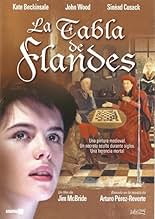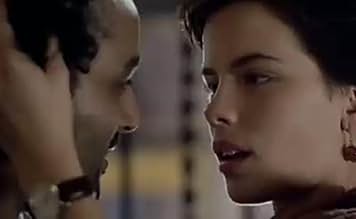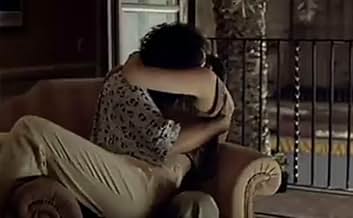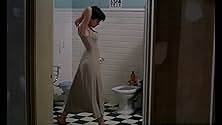NOTE IMDb
5,7/10
2,9 k
MA NOTE
Ajouter une intrigue dans votre langueA woman finds a hidden message in a restored painting questioning a knight's death. When her friend is murdered investigating it, a chess game's moves in the painting link to killings from t... Tout lireA woman finds a hidden message in a restored painting questioning a knight's death. When her friend is murdered investigating it, a chess game's moves in the painting link to killings from the past that she must solve.A woman finds a hidden message in a restored painting questioning a knight's death. When her friend is murdered investigating it, a chess game's moves in the painting link to killings from the past that she must solve.
- Réalisation
- Scénario
- Casting principal
Sinéad Cusack
- Menchu
- (as Sinead Cusack)
Julian Martínez
- Duke Ferdinand
- (as Julián Martínez)
Isabel van Unen
- Beatrix of Burgundy
- (as Isabel Van Unen)
Josuè Guasch
- Messenger
- (as Josue Guasch)
Avis à la une
Julia (Kate Beckinsale) an art restorer finds a hidden message in medieval painting she is working on that points to the murderer of one of the subjects depicted. Fascinated she digs deeper into the origins of the painting and the clues within. The old mystery though is soon paralleled by a new mystery as the people involved in her research start to die. The story is seemingly well suited to the British mystery genre but fails largely due to aspects of the execution.
Kate Beckinsale manages with her portrayal to be both slightly awkward as well as endearingly cute but she seems decidedly out of her depth in a few of the more emotional/dramatic scenes. The film does boast a strong supporting cast of British character actors who may not have name recognition to some but should be highly recognizable to many including; John Wood, Sinead Cusack, Michael Gough. For the most part the supporting cast acquit themselves well considering how clichéd their characters are.
While some may find it slow I was interested in the glimpse at the Art restoration process, I thought some things look authentic about the process, but other aspects didn't quite ring true. The current day murder mystery aspect was far less satisfying, character behavior and actions seemed inconsistent and for me the biggest flaw (considering the genre) was that the identity of the murderer seemed far to obvious. Further the brief flashbacks to the subjects of the painting did virtually nothing to advance or support the story, they simply felt unnecessary.
The film is set in Barcelona but features an almost entirely English cast that speaks entirely in English and makes no attempt at Spanish accents. This is common in American films but seemed odd in a British film. The film makes reasonable use of the Barcelona locations including some wonderful Gaudi architecture, but I actually would have preferred even more attention on the culture and the city.
Kate Beckinsale manages with her portrayal to be both slightly awkward as well as endearingly cute but she seems decidedly out of her depth in a few of the more emotional/dramatic scenes. The film does boast a strong supporting cast of British character actors who may not have name recognition to some but should be highly recognizable to many including; John Wood, Sinead Cusack, Michael Gough. For the most part the supporting cast acquit themselves well considering how clichéd their characters are.
While some may find it slow I was interested in the glimpse at the Art restoration process, I thought some things look authentic about the process, but other aspects didn't quite ring true. The current day murder mystery aspect was far less satisfying, character behavior and actions seemed inconsistent and for me the biggest flaw (considering the genre) was that the identity of the murderer seemed far to obvious. Further the brief flashbacks to the subjects of the painting did virtually nothing to advance or support the story, they simply felt unnecessary.
The film is set in Barcelona but features an almost entirely English cast that speaks entirely in English and makes no attempt at Spanish accents. This is common in American films but seemed odd in a British film. The film makes reasonable use of the Barcelona locations including some wonderful Gaudi architecture, but I actually would have preferred even more attention on the culture and the city.
No question in my mind, there's no question that the vitality of film these days is in the hands of Spanish storytelling: layered narrative, magical deviations from causality, sex as physics. The beauty of woman and places deeply rooted to the elegance of understanding.
There are narrative notions and cinematic qualities being nurtured in this broad community that are worth nurturing by us through appreciation. Here's a project that when you sum it all up is a dreadful movie, but it knows what it is about in terms of some intelligent ideas. It just didn't have the talent to match those ideas.
Here's the deep spine which is attempted: Pérez-Reverte writes mystery stories in a magical realism tradition. His device is usually to play between the happening of a thing and the representation of that happening in a book or painting. The idea is to fold his representation (his book) into the story, reaping all sorts of storytelling advantages.
Once these layers are established, he can jump in and out of various levels, and so can we as readers and some of the main characters as they develop insight. Layers are narrative layers, story threads, time, and almost always abstraction layers in terms of creating events and creating laws behind those events.
But the books themselves have problems. The ideas in their construction are a whole lot more engaging than the books themselves. The actual skill at storytelling just isn't masterful enough to control, channel and exploit these conceptual tides that have been unleashed.
One of his books was made into a film by a true master filmmaker, Polanski, and starred someone who knows that rare trick of layered or folded acting, where you inhabit more than one layer at a time. You had to work at it, but "Ninth Gate" really is as good as its ideas, and the ideas are in that film are both richer and crisper than in the source book.
And now we have this film of another of Pérez-Reverte's works. A simpler book in key ways.
One change it makes is to relocate the story to Barcelona and Gaudi's architecture. He is our most "folded" architect, and that change shows some real understanding of what is at stake. The filmmaker here is the guy who best exploited the environmental fabric of New Orleans to transform a simple story into a pretty interesting film in "The Big Easy."
For some reason, he is unable to do the same here. I think he could have if he had more time to get into the rhythm of the place, which is less hedonistic than New Orleans but more achingly romantic; more poundingly African under a sunny, slightly mechanical nonchalance. The project could have used this, and it was in his power, but it eludes us this time.
And that lack of control extends to more mundane production elements. The balance between realism and theatrical stereotypes/architypes was lost, probably unachievable with this cast.
The cast centers on Kate Beckinsale as our surrogate detective, who really is alluring, and in precisely the way the project demands: physically, she is made here as befitting of the place: sloppy, casual (unshaven pits), boyish face, innocent questioner on the surface -- deeply sexual and possibly powerful underneath. But she couldn't deliver that last part, the power part. Indeed, any emotion is amateurish. I haven't really paid much attention to her later work. I think it about the same.
So. What we have is a parcel of really great ideas. Important, central ones if you love movies and seriously use them in building a life and life awareness. These are all here, but mostly implicit. You have to almost ignore the movie to see them.
But along the way, you get a pretty girl, the most intriguing city on the planet, and a painting that is worthy of its role.
Ted's Evaluation -- 2 of 3: Has some interesting elements.
There are narrative notions and cinematic qualities being nurtured in this broad community that are worth nurturing by us through appreciation. Here's a project that when you sum it all up is a dreadful movie, but it knows what it is about in terms of some intelligent ideas. It just didn't have the talent to match those ideas.
Here's the deep spine which is attempted: Pérez-Reverte writes mystery stories in a magical realism tradition. His device is usually to play between the happening of a thing and the representation of that happening in a book or painting. The idea is to fold his representation (his book) into the story, reaping all sorts of storytelling advantages.
Once these layers are established, he can jump in and out of various levels, and so can we as readers and some of the main characters as they develop insight. Layers are narrative layers, story threads, time, and almost always abstraction layers in terms of creating events and creating laws behind those events.
But the books themselves have problems. The ideas in their construction are a whole lot more engaging than the books themselves. The actual skill at storytelling just isn't masterful enough to control, channel and exploit these conceptual tides that have been unleashed.
One of his books was made into a film by a true master filmmaker, Polanski, and starred someone who knows that rare trick of layered or folded acting, where you inhabit more than one layer at a time. You had to work at it, but "Ninth Gate" really is as good as its ideas, and the ideas are in that film are both richer and crisper than in the source book.
And now we have this film of another of Pérez-Reverte's works. A simpler book in key ways.
One change it makes is to relocate the story to Barcelona and Gaudi's architecture. He is our most "folded" architect, and that change shows some real understanding of what is at stake. The filmmaker here is the guy who best exploited the environmental fabric of New Orleans to transform a simple story into a pretty interesting film in "The Big Easy."
For some reason, he is unable to do the same here. I think he could have if he had more time to get into the rhythm of the place, which is less hedonistic than New Orleans but more achingly romantic; more poundingly African under a sunny, slightly mechanical nonchalance. The project could have used this, and it was in his power, but it eludes us this time.
And that lack of control extends to more mundane production elements. The balance between realism and theatrical stereotypes/architypes was lost, probably unachievable with this cast.
The cast centers on Kate Beckinsale as our surrogate detective, who really is alluring, and in precisely the way the project demands: physically, she is made here as befitting of the place: sloppy, casual (unshaven pits), boyish face, innocent questioner on the surface -- deeply sexual and possibly powerful underneath. But she couldn't deliver that last part, the power part. Indeed, any emotion is amateurish. I haven't really paid much attention to her later work. I think it about the same.
So. What we have is a parcel of really great ideas. Important, central ones if you love movies and seriously use them in building a life and life awareness. These are all here, but mostly implicit. You have to almost ignore the movie to see them.
But along the way, you get a pretty girl, the most intriguing city on the planet, and a painting that is worthy of its role.
Ted's Evaluation -- 2 of 3: Has some interesting elements.
Julia (Kate Beckinsale) is a restorer working in a five hundred years old painting, which theme is a chess game: there are two men playing chess and a woman watching them. This painting will be sold in an auction after the restoration, and the amount will be split among the owner, an old man who lost his wealthy, Julia's best friend Menchu (Sinéad Cusack) and her partner. Max and Lola, relatives of the owner, are very interested in the selling. Julia has no family and was raised by Cesar (John Wood), who has a fraternal love for her. Cesar is also homosexual. Julia finds a hidden message in Latin in the paint, an after some investigation, she finds out that the translation would be `Who killed the knight?' Soon, many characters are associated to the pieces of the chess and are killed, following the movements of the game in the painting. This incredible and complex plot is a great disappointment. One of the attraction is Kate Beckinsale in the beginning of her career, with a beautiful body and breasts, but with a rough and common face. Presently, nine years older than in this movie, she is very gorgeous, very well produced in her films, with a delicate face, thin nose, beautiful and long hair and wonderful costumes. My vote is five.
A young art restoration specialist based in Barcelona is retained by an art gallery to restore a 17th century Dutch Masters paainting that has been in a private collection since it was created. The painting depicts an elderly nobleman playing cards with a younger man, while a noblewoman watches in the backgrounnd. All restorations include an xray, and this image reveals an underlying original painting on the same two men playing chess instead of cards. On the lower right, in Latin, are the words "Who Killed the Knight." The film reveals the names of the people in the painting, their relationships to each other, and how they relate to the current owners.
This is a reasonably suspenseful film with qhite a few surprises. The performances are ot bad, although Kate Beckensale's inexperience is glaring. The story, however, more than compensates for this modest short coming, and the sight of the scantily clad beautiful English actress at age 21 is quite breathtaking.
This is a reasonably suspenseful film with qhite a few surprises. The performances are ot bad, although Kate Beckensale's inexperience is glaring. The story, however, more than compensates for this modest short coming, and the sight of the scantily clad beautiful English actress at age 21 is quite breathtaking.
"Uncovered" is based on Arturo Pérez-Reverte's novel "The Flanders Panel". Julia Darro, a young art historian and restorer from Barcelona, is working on a fifteenth-century Flemish painting called "The Game of Chess", when she discovers a painted-over message reading "Quis Necavit Equitem?" (Latin for "Who killed the knight?") Julia begins to research the painting's background to discover the meaning of this inscription, and discovers that it relates to a 500-year-old murder mystery. She realises that the solution to the mystery is connected to the chess game being played in the picture, and knowing little of the game herself recruits Domenec, a talented local chess player, to assist her. Julia and Domenec, however, realise that they are in danger, as several people connected with their research are also murdered.
The central mystery is an intriguing and ingenious one, and well developed, although I could spot the identity of the murderer well before this was announced on screen. There are no really outstanding acting performances, but the lovely Kate Beckinsale makes a charming heroine (although I could never work out why she sneezes so much). Kate is one of the few actresses who can get away with wearing her hair boyishly short and still look strikingly beautiful.
One criticism I have heard is that although the main characters are all supposed to be Spanish they all speak English without foreign accents. This, however, is not something which has ever worried me. The use of native British or American accents to represent foreigners' use of their own native languages is something I find perfectly acceptable. Charlton Heston's El Cid, for example, was also a Spaniard, and nobody complains that he speaks English like an American rather than like Manuel in "Fawlty Towers".
This is one of the few films to take an interest in chess and art history, two rather intellectual pursuits, and it does so in such a way as to make both those subjects seem interesting, even glamorous, featuring a romance between a beautiful young art historian and a handsome chess genius. It makes good use of its setting, with some wonderful views of the city of Barcelona, especially the architecture of Antoni Gaudi. (One of the characters lives in an apartment in Casa Batlló, and Julia and Domenec first meet in Park Güell).
Although this film was an Anglo-Spanish co-production, and stars a well-known English actress, it is curiously unknown in Britain. Although it is nearly twenty years since it was made, I have never seen it on television here, and it is available on DVD in the US but not in the UK. Yet it is, I think, a film which deserves to be better-known. 7/10
The central mystery is an intriguing and ingenious one, and well developed, although I could spot the identity of the murderer well before this was announced on screen. There are no really outstanding acting performances, but the lovely Kate Beckinsale makes a charming heroine (although I could never work out why she sneezes so much). Kate is one of the few actresses who can get away with wearing her hair boyishly short and still look strikingly beautiful.
One criticism I have heard is that although the main characters are all supposed to be Spanish they all speak English without foreign accents. This, however, is not something which has ever worried me. The use of native British or American accents to represent foreigners' use of their own native languages is something I find perfectly acceptable. Charlton Heston's El Cid, for example, was also a Spaniard, and nobody complains that he speaks English like an American rather than like Manuel in "Fawlty Towers".
This is one of the few films to take an interest in chess and art history, two rather intellectual pursuits, and it does so in such a way as to make both those subjects seem interesting, even glamorous, featuring a romance between a beautiful young art historian and a handsome chess genius. It makes good use of its setting, with some wonderful views of the city of Barcelona, especially the architecture of Antoni Gaudi. (One of the characters lives in an apartment in Casa Batlló, and Julia and Domenec first meet in Park Güell).
Although this film was an Anglo-Spanish co-production, and stars a well-known English actress, it is curiously unknown in Britain. Although it is nearly twenty years since it was made, I have never seen it on television here, and it is available on DVD in the US but not in the UK. Yet it is, I think, a film which deserves to be better-known. 7/10
Le saviez-vous
- AnecdotesHelen McCrory's debut.
Meilleurs choix
Connectez-vous pour évaluer et suivre la liste de favoris afin de recevoir des recommandations personnalisées
- How long is Uncovered?Alimenté par Alexa
Détails
- Date de sortie
- Pays d’origine
- Langues
- Aussi connu sous le nom de
- La tabla de Flandes
- Lieux de tournage
- Sociétés de production
- Voir plus de crédits d'entreprise sur IMDbPro
- Durée1 heure 43 minutes
- Couleur
- Mixage
- Rapport de forme
- 1.66 : 1
Contribuer à cette page
Suggérer une modification ou ajouter du contenu manquant



























